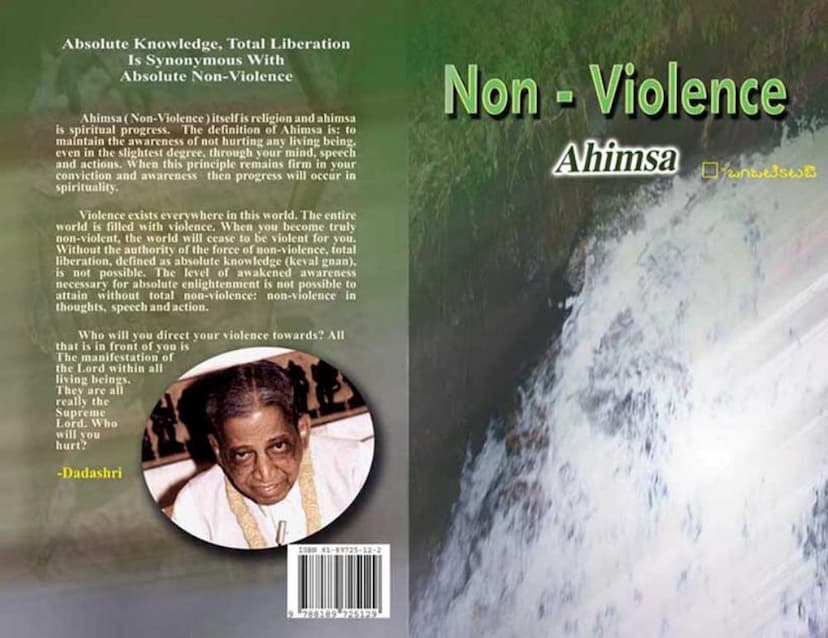Non Violence
Added to library: September 2, 2025

Summary
Here's a comprehensive summary of the Jain text "Non Violence" by Dada Bhagwan, based on the provided pages:
The central theme of this text is Ahimsa (Non-Violence), presented not merely as an absence of physical harm, but as a profound spiritual principle encompassing thoughts, speech, and actions. Dada Bhagwan, a "Gnani Purush" (Enlightened One), elucidates that Ahimsa is synonymous with absolute knowledge and total liberation.
Key Concepts and Teachings:
- Ahimsa as Religion and Progress: Ahimsa is equated with religion itself and is the path to spiritual progress. Maintaining an awareness of not hurting any living being, even minimally, through mind, speech, and action is the core definition.
- The Pervasiveness of Violence and the Solution of Non-Violence: The world is described as being filled with violence. True non-violence, however, transforms one's perception, making the world cease to be violent for the individual. The author emphasizes that absolute liberation is impossible without total non-violence.
- The Lord Within: Dada Bhagwan teaches that the Divine Lord resides within all living beings. Hurting any being is therefore hurting the manifestation of the Lord.
- The Nature of Violence (Himsa) and Non-Violence (Ahimsa):
- Gross vs. Subtle Violence: While overt physical aggression is understood as violence, the spiritual definition is much broader, including hurtful speech and thoughts (intent-violence).
- Intent-Violence (Bhav Himsa): This is considered the most serious form of violence, happening within the mind. Anger, pride, greed, and delusion (kashayas) are highlighted as the ultimate forms of violence against oneself and the Soul.
- Effect Violence: This is the outward, visible violence through actions. While significant, it's stressed that intent-violence is far more damaging.
- Akram Vignan (The Shortcut Path): Dada Bhagwan's teachings are rooted in Akram Vignan, a direct and "step-less" path to Self-Realization, imparted through a scientific process called "Gnan Vidhi." This process can impart the knowledge of the Self within hours.
- The Role of the Gnani Purush: True understanding of Ahimsa and its subtle aspects can only come from a Gnani Purush, who embodies the knowledge of the Tirthankaras. The Gnani is the non-violent one within an ocean of violence.
- Karma and Its Impact: All actions, thoughts, and speech create karma. Violence, especially intent-violence, leads to negative karma and binds one to the cycle of birth and death. However, the Self-Realized being, identified with the Pure Soul, is not affected by karma.
- Practical Guidance on Ahimsa:
- Bedbugs and Insects: Individuals are advised not to kill bedbugs or insects, viewing them as settling past debts. Rather than killing, they should be relocated. Using insecticides is discouraged.
- Diet: A vegetarian diet is strongly recommended. The avoidance of meat, eggs, onions, and garlic is advised, as these foods can incite anger and dull awareness. The importance of eating at specific times (before sunset) is also mentioned for health and spiritual progress.
- Intent of Non-Violence: The emphasis is on maintaining the intent of not hurting any living being. If accidental harm occurs, repentance and seeking forgiveness (pratikraman) are crucial.
- Occupations: Occupations involving violence, like farming or butchery, are acknowledged. While unavoidable, the practice of pratikraman and maintaining the inner intent of non-violence is emphasized.
- Confrontation and Opposition to Violence: While personal non-violence is key, it's also important to oppose violence in society. This opposition should be done with a non-violent intent.
- The Self and Ownership: The core of achieving true non-violence lies in realizing oneself as the Pure Soul ("Shuddhatma") and detaching from the ego and ownership of the body. The Self is described as unaffected by any external actions, including violence.
- Intellect and its Misuse: While increased intellect can lead to greater awareness of violence, it can also be misused for exploitative purposes, which is a greater form of violence.
- Sex and Violence: Sexual activity, even within marriage, involves violence due to the destruction of subtle life forms. Control over sexual desires is crucial for spiritual progress.
- The Nature of the Self: The Self is described as pure, unaffected, and distinct from the body and its actions. It is like light that cannot be tainted by mud.
Overall Message:
The book "Non Violence" by Dada Bhagwan provides a profound and practical understanding of Ahimsa, moving beyond superficial adherence to a deep internal transformation. It emphasizes that true non-violence originates from the purity of one's intentions and the realization of the Self, leading to liberation from the cycle of suffering and violence. The teachings are presented as a scientific approach to spiritual living, accessible to all.